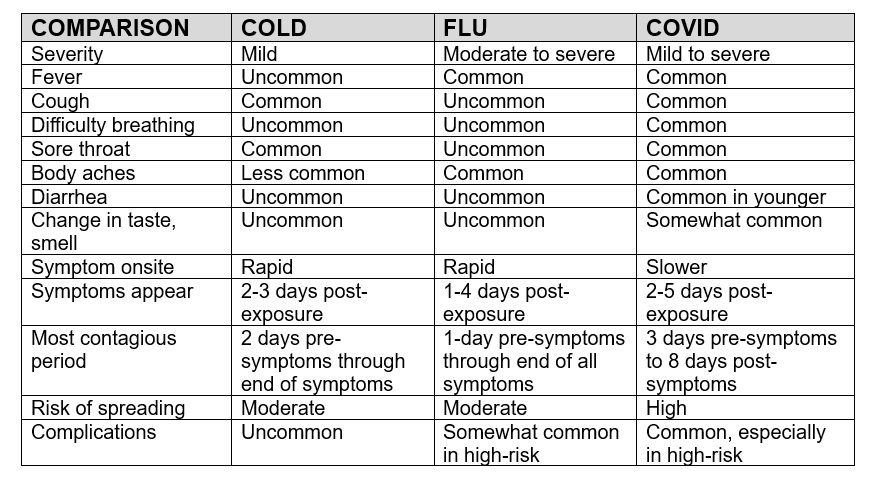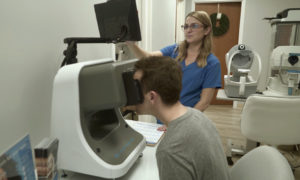
Photo credit: Getty Images
Creating an office policy for sick employees
By Joe DeLoach, OD, FAAO
April 10, 2024
In the past four years, we lived through one of the most challenging periods of running a business. The COVID-19 experience left a new blueprint for infection control in the healthcare environment.
Make no mistake, COVID and its seemingly endless variants are still around. While the “mandates” from the CDC are no longer in place, recommendations and common sense still apply.
The challenges of COVID heightened most healthcare workers’ attention to infection control – but not all infection in the workplace is COVID. In fact, most are not. The common cold and seasonal flu are still in the air, just like they were pre-pandemic.
What is YOUR Protocol for Sick Employees?
Before diving into the current recommendations for general respiratory precautions, we asked some of our colleagues how they deal with symptomatic employees. The answers were interestingly varied.
“We take the temperature of any employee with cold or flu symptoms and send any employee with fever home until they have no fever for 48 hours.”
“Employees are asked to use their common sense and not come to work if they feel bad.”
“We allow employees without fever to remain at work or go home – their choice. If they remain at work they must wear a mask.”
“Our policy is any employee who has cold or flu symptoms must inform us, and they are told not to come to work or are sent home. We do not wait until they have a fever or get a test result.”
“We follow the CDC mandates for infection control.”
What SHOULD we be doing?
The answers can no longer be found in CDC mandates. The CDC currently has recommendations for all respiratory infection control, including COVID, but no mandates.
OSHA also has guidelines for infection control in the workplace. We are seeing a return of local recommendations and even mandates, so check with your state and local rules. These recommendations are included for reference at the end of the article.
Without specific mandates, each doctor is left to make their own policies for preventing the spread of airborne disease.
Before making a shallow dive into those recommendations, we should review how these different viruses present. While all three viruses can cause common symptoms, there are differences.

Still Comes Down to Your Best Judgment as Employer
So, that cleared everything up. It is obvious that relying totally on symptoms can be misleading. Throw in that simple allergy, possibly the most common respiratory condition, can mimic all these diseases and it can be a muddy picture. If you’re not sure, testing is still a consideration.
Other Articles to Explore
The CDC created a new information site called Project Firstline. The recommendations presented are stated to be for ALL symptomatic presentations. In general, they are similar to the standard guidelines presented by OSHA. They include the following:
- Respiratory hygiene and cough etiquette
- Use of masks by symptomatic workers
- Physical distancing
- Hand washing
- Clean and disinfect
- Adequate air handling and ventilation
OSHA mandates an infection control policy for all healthcare providers with guidance on what that may look like.
With that in mind, let’s revisit the responses we received from across the U.S. Keep in mind, none should be considered completely right or wrong. The decisions are individual.
“We take the temperature of any employee with cold or flu symptoms and send any employee with fever home until they have no fever for 48 hours.”
The presence of a fever can increase our concern. While not a mandate, not having symptomatic employees with fever in the office would be highly recommended.
“Employees are asked to use their common sense and not come to work if they feel bad.”
Personally, I don’t like being told what to do, so love the answer. Unfortunately, some individuals are severely lacking in that thought process. A structured policy would be a better idea.
“We allow employees without fever to remain at work or go home – their choice. If they remain at work they must wear a mask.”
Definitely a bolder policy, but again, it’s pick your own poison time. Masks are very beneficial, but not 100 percent effective. Any employee allowed to stay at work should definitely be isolated from other workers and especially patients.
“Our policy is any employee who has cold or flu symptoms must inform us, and they are told not to come to work or are sent home. We do not wait until they have a fever or get a test result.”
Certainly, the most aggressive policy – and again cannot be stated as wrong. More attention to the details of the symptoms and possibly testing could lead to less impact on the workforce.
“We follow the CDC mandates for infection control.”
Good idea – but remember they are simply guidelines, not mandates.
While not always an easy or accurate decision, each of us is charged to make our own policies regarding infection control in the office.
Know the guidelines, throw in a good dose of common sense, and we can all go a long way toward decreasing the spread of respiratory infections in the workplace.
Resources for Employers
The site contains specific information and recommendations for seasonal colds and flu as well as COVID and RSV.
CDC Guidelines for Standard Precautions
 Joe DeLoach, OD, FAAO, is CEO of Practice Compliance Solutions. and former Clinical Professor at the University of Houston College of Optometry To contact: : joe@practicecompliancesolutions.com
Joe DeLoach, OD, FAAO, is CEO of Practice Compliance Solutions. and former Clinical Professor at the University of Houston College of Optometry To contact: : joe@practicecompliancesolutions.com

























